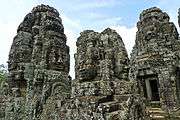Siem Reap Province
Siem Reap, officially Siemreap[3] (Khmer: សៀមរាប pronounced [siəm.ˈriəp], "Defeat of Siam"), is a province (khaet) of Cambodia. It borders the provinces of Oddar Meanchey to the north, Preah Vihear and Kampong Thom to the east, Battambang to the south, and Banteay Meanchey to the west. Its capital and largest city is Siem Reap.
Siem Reap Province សៀមរាប | |
|---|---|
  .jpg) | |
 Seal | |
| Nickname(s): Gateway to Angkor | |
 Map of Cambodia highlighting Siem Reap | |
| Coordinates: 13°21′N 103°51′E | |
| Country | |
| Settled | 802 |
| Provincial status | 23 December 1907[1] |
| Capital | Siem Reap Municipality |
| Government | |
| • Governor | Tea Seyha (CPP) |
| • National Assembly | 6 / 125
|
| Area | |
| • Total | 10,299 km2 (3,976 sq mi) |
| Area rank | 10th |
| Population (2019)[2] | |
| • Total | |
| • Rank | 4th |
| • Density | 98/km2 (250/sq mi) |
| • Density rank | 13th |
| Time zone | UTC+7 (ICT) |
| Dialing code | 087629502+855 |
| ISO 3166 code | KH-17 |
| Districts | 12 |
| Communes | 100 |
| Villages | 907 |
| Website | siemreap |
Siem Reap is the 10th largest province in Cambodia. Having reached a population of 1 million in 2019, it ranks as the nation's fourth largest.[2] A large portion of Siem Reap's southern border is demarcated by the Tonle Sap and as such, it is one of the nine provinces that making up the Tonle Sap Biosphere Reserve. In modern times the province is best known as the site of Angkor and the Angkor Wat temple ruins, UNESCO World Heritage Site. It is also the home of Banteay Srei, Roluos (temples), UNESCO tentative site of Beng Mealea, and UNESCO tentative site of Phnom Kulen National Park (home to the country's largest reclining Buddha).
Etymology
The name Siem Reap literally means 'Siam defeated', a reminder of the centuries-old conflict between the Siamese and the Khmer. In Siam, the province and its capital were called Siemmarat (Thai: เสียมราฐ), literally meaning 'Siam's territory'.[4]
History
The province came under the control of the Thai kingdom of Siam in 1795 and was later returned to Cambodia in 1907 after French made a treaty with Siam for exchange of Trat and Dan Sai for the Siamese province of Inner Cambodia which included Phra Tabong (Battambang), Siemmarat (Siem Reap), and Nakhon Wat (Angkor Wat). The Inner Cambodia province was split into Battambang and Siem Reap by the royal decree of King Sisowath the same year. This area became part of a disputed territory between France and Siam (now Thailand) which led to the Franco-Thai War in 1941, resulting in victory for Thailand and a return to Thai control (with exception of Siem Reap and Angkor Wat). The province again reverted to Cambodia in 1946, after the end of World War II with French and UN international pressure.
Subdivisions
The province is divided into 12 districts, 100 communes and 907 villages.[5]
| ISO Code | District | Khmer |
|---|---|---|
| 17-01 | Angkor Chum | ស្រុកអង្គរជុំ |
| 17-02 | Angkor Thom | ស្រុកអង្គរធំ |
| 17-03 | Banteay Srei | ស្រុកបន្ទាយស្រី |
| 17-04 | Chi Kraeng | ស្រុកជីក្រែង |
| 17-06 | Kralanh | ស្រុកក្រឡាញ់ |
| 17-07 | Puok | ស្រុកពួក |
| 17-09 | Prasat Bakong | ស្រុកប្រាសាទបាគង |
| 17-10 | Siem Reap Municipality | ក្រុងសៀមរាប |
| 17-11 | Sout Nikom | ស្រុកសូទ្រនិគម |
| 17-12 | Srei Snam | ស្រុកស្រីស្នំ |
| 17-13 | Svay Leu | ស្រុកស្វាយលើ |
| 17-14 | Varin | ស្រុកវ៉ារិន |

 View from Phnom Bakheng
View from Phnom Bakheng South gate of Angkor Thom
South gate of Angkor Thom Bayon Temple
Bayon Temple
References
- "History of Siem Reap". siemreap.gov.kh. Retrieved 17 August 2019.
- "General Population Census of the Kingdom of Cambodia 2019". National Institute of Statistics. Ministry of Planning. June 2019. Retrieved 12 August 2019.
- "Geographical Names of the Kingdom of Cambodia" (PDF). UNSTATS. Eighth United Nations Conference on the Standardization of Geographical Names. Retrieved 7 June 2019.
- Article 6 of the "Convention between France and Siam Amending the Stipulations of the Treaty of 8 October 1904, Concerning the Territories and the Other Arrangements, Signed at Paris, the 13th February 1904."
- "Administration; Siem Reap". Kingdom of Cambodia. Archived from the original on 27 May 2009. Retrieved 27 June 2010.
External links
| Wikimedia Commons has media related to Siem Reap Province. |